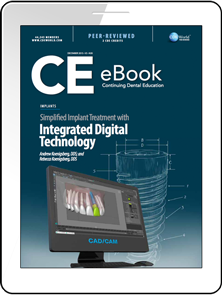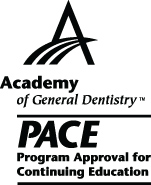CDEWorld > eBooks > Simplified Implant Treatment with Integrated Digital Technology


ADA CERP is a service of the American Dental Association to assist dental professionals in identifying quality providers of continuing dental education. ADA CERP does not approve or endorse individual courses or instructors, nor does it imply acceptance of credit house by boards of dentistry. Concerns or complaints about a CE provider may be directed to the provider or to ADA CERP at www.ada.org/cerp/

Approved PACE Program Provider. FAGD/MAGD credit. Approval does not imply acceptance by a state or provincial board of dentistry, or AGD endorsement. 1/1/2023 to 12/31/2028. ID # 209722.
eBook
Released: Friday, December 11, 2015
Expires: Thursday, May 31, 2018
Simplified Implant Treatment with Integrated Digital Technology
By Andrew Koenigsberg, DDS; and Rebecca Koenigsberg, DDS
Commercial Supporter: Benco Dental
Dental implant therapy has been revolutionized in the last few years by advances in digital imaging and computer-aided design and computer-aided manufacture (CAD/CAM) and the ability to integrate the two technologies. While implant therapy has been done successfully for decades, “integrated digital implant technologies” provide many advantages to the patient, doctor, and laboratory technician. With the advent of new technologies and materials, many surgical procedures (think cardiac and knee surgery) have become faster, more precise, and less traumatic. So too has dental implant surgery evolved, and can now be done faster, less traumatically, and with more precision. This article will familiarize the dental practitioner with the ways in which CAD/CAM and cone-beam computerized tomography (CBCT) enhance implant treatment planning, implant placement, and implant restoration. An emphasis will be placed on simplified workflow, as this is the most important factor in incorporating new technologies on a routine basis. It is important to recognize that these technologies are still young and that there will continue to be improvements in every phase. Nevertheless, these technologies are developed sufficiently at present to provide significant advantages in all phases of implant treatment.
LEARNING OBJECTIVES:
-
Describe the advantages of integrating CAD/CAM and CBCT to enhance implant treatment planning, implant placement, and implant restoration.
-
Discuss how these technologies can lead to a simplified workflow in the dental practice.
-
List the advantages that “integrated digital implant technologies” bring to the patient.
About the Authors
Dr. Andrew Koenigsberg founded the Manhattan group practice Gallery57Dental. A graduate of Columbia University School of Dental and Oral Surgery, Dr. Koenigsberg has himself taught predoctoral students at Columbia as well as postgraduate students maxillofacial prosthetics at Montefiore Hospital’s Postgraduate Prosthodontics program. In 2010 he cofounded CAD/CAM Excellence, a continuing education center, where he is clinical director.
Dr. Rebecca Koenigsberg is a graduate of Columbia University College of Dental Medicine, and completed a 1-year General Practice Residency at Montefiore Medical Center. She is one of the first dentists in New York to be certified in the use of the Solea laser technology, allowing her to treat many patients without the use of of drill or injection.
Download FREE eBook now!

